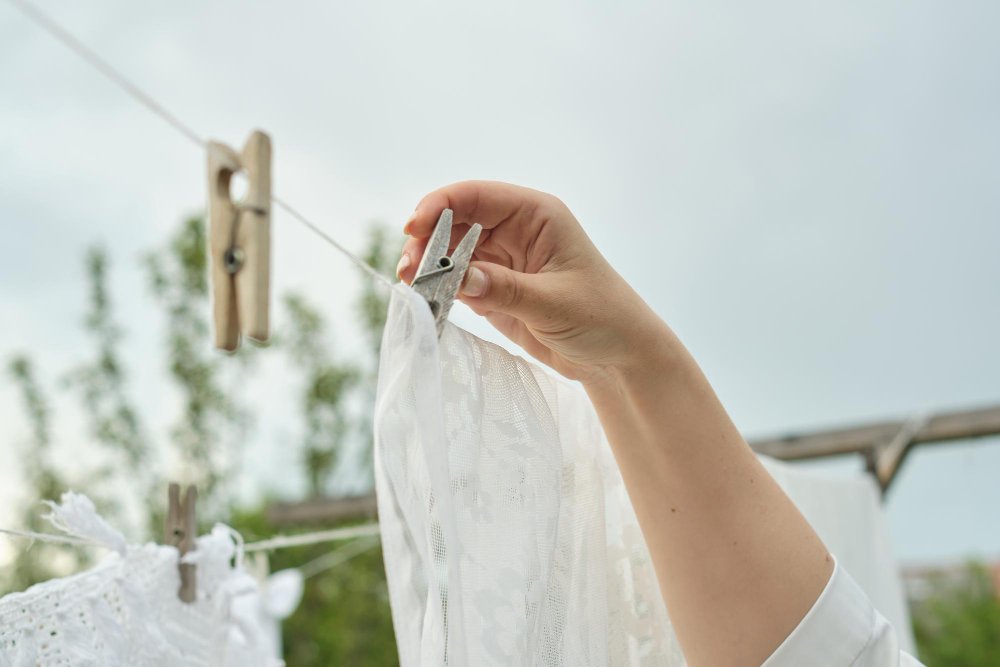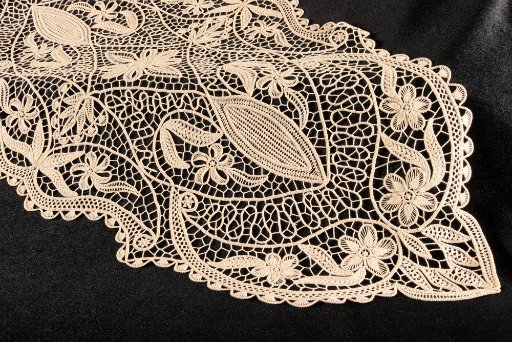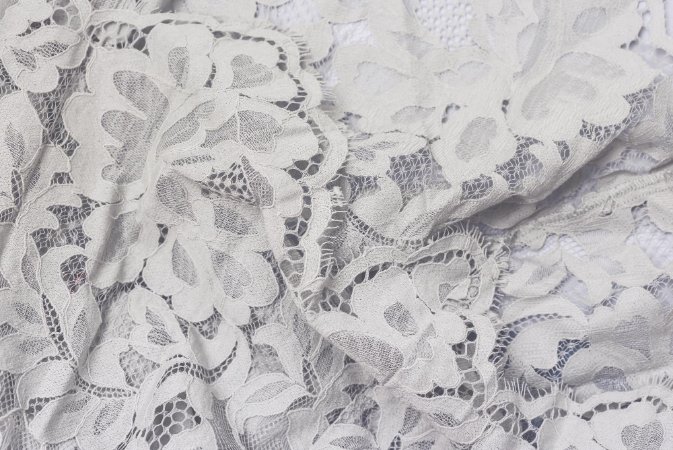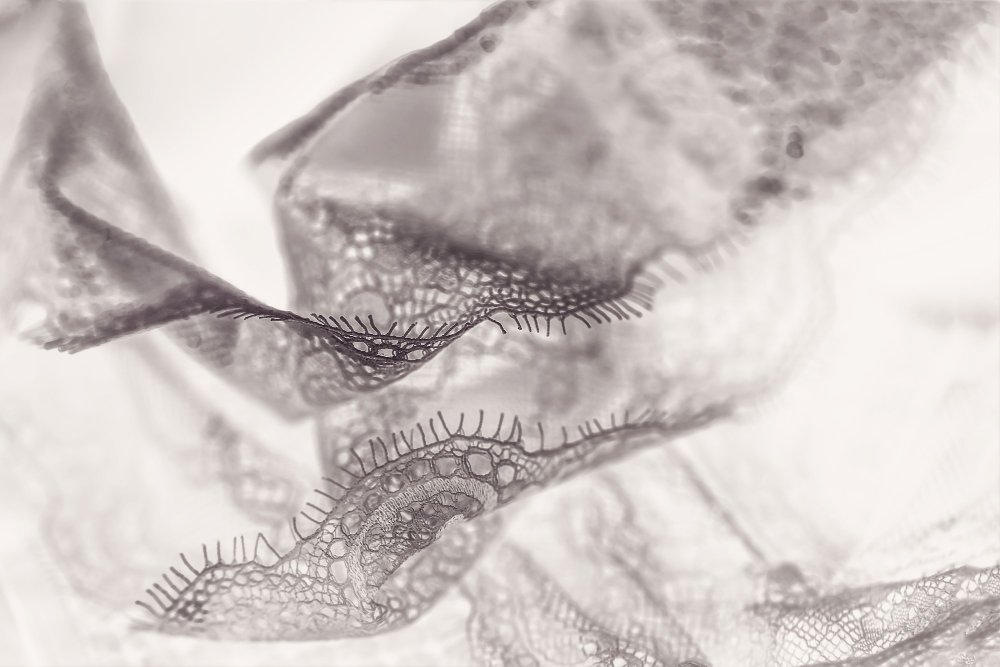From 17th-century Italian workshops to 2025’s sustainable lace-making revival
What is the Mezzo Punto Lace Technique?
Mezzo punto is a specialized lace-making technique that originated in 17th-century Italy. The name literally translates to “half stitch” in Italian, referring to the method’s unique approach of combining pre-made tape elements rather than building patterns from individual threads like traditional needle lace techniques.
This innovative technique stands apart from other lace-making methods because it uses a foundation of woven or bobbin-made tapes that are arranged into patterns and connected with delicate needlepoint fillings called “brides.” The lace fabric that results from this technique balances efficiency with exceptional hand-crafted quality.
Hand-stitched details per square foot in authentic pieces
Years of continuous artistic tradition
of Americans cannot identify authentic examples
Annual market value of lace made with this technique
Key Characteristics of the Mezzo Punto Method
What makes mezzo punto unique among lace techniques is its modular construction approach. Unlike Chantilly lace that works continuously or needle lace that builds from scratch, mezzo punto assembles pre-made components into complex designs. This method allows for:
- Structural durability: The tape foundation provides strength while maintaining delicate appearance
- Design flexibility: Tapes can be arranged into countless patterns and motifs
- Efficient production: Faster than pure needlework while maintaining artisanal quality
- Easy repair: Individual sections can be restored without affecting the entire piece
| Technique | Construction Method | Production Time | Resulting Lace Uses |
|---|---|---|---|
| Mezzo Punto | Pre-made tapes + needlepoint fillings | 8-12 hours | Decorative panels, garment trim |
| Chantilly Technique | Continuous bobbin work | 15-25 hours | Bridal veils, evening wear |
| Needle Lace Method | Single needle and thread | 40-60 hours | Heirloom pieces, museum collections |
Historical Origins and Evolution of the Mezzo Punto Technique
The story of mezzo punto begins in the Italian textile workshops of the early 1600s, where innovative artisans sought faster lace-making methods to meet growing demand for decorative textiles without sacrificing quality.
Italian artisans in Genoa, Naples, and Milan develop early tape lace techniques as alternatives to time-intensive Venetian needlework. The technique emerges from practical needs to produce religious vestments and noble garments more efficiently.
The Victoria and Albert Museum’s earliest documented mezzo punto lace shows technical mastery already achieved by Italian craftsmen, featuring intricate border work for religious garments.
French artisans embrace and refine Italian techniques, introducing signature floral motifs and geometric patterns that influence French lace traditions. Cross-cultural exchange creates new aesthetic possibilities.
Industrial Revolution transforms production with machine-made tapes, making the technique accessible to middle classes. The method spreads globally through trade routes.
Revival period sees mezzo punto techniques rebranded as “Renaissance lace” in Europe and America. Pattern books become widely available, making the method popular for home crafters.
Sustainable fashion movement drives renewed interest in traditional techniques. Modern lacemakers combine mezzo punto methods with eco-friendly materials, creating new market opportunities.
The Italian Innovation
Italian artisans developed the mezzo punto technique during a period of economic prosperity when wealthy patrons demanded increasingly elaborate textiles. Traditional needlelace methods, while beautiful, required months to complete single pieces. Mezzo punto offered a solution that reduced production time by using pre-made tape elements while preserving the intricate beauty that made Italian lace famous throughout Europe.
French Refinement and European Spread
When French craftsmen encountered Italian mezzo punto techniques in the mid-1600s, they elevated the method through refined Renaissance design principles. French artisans introduced mathematical precision in pattern layouts, delicate floral motifs inspired by court gardens, and architectural elements that reflected French aesthetic preferences. This cross-cultural exchange established mezzo punto as a luxury technique throughout European courts.
Global Expansion and Modern Revival
By the 18th century, mezzo punto techniques had spread through global trade networks. Artisans adapted methods to local materials and cultural preferences while preserving core principles. The technique’s recent revival reflects growing appreciation for traditional craftsmanship and sustainable production methods that align with contemporary values.
Mezzo Punto Technique Methods, Materials, and Designs
Understanding mezzo punto construction reveals why this technique has remained relevant for over four centuries. The method balances traditional hand skills with practical efficiency, making it adaptable to both historical reproduction and contemporary innovation.
Two Primary Mezzo Punto Methods
| Method | Tape Type | Best Application | Time Required | Skill Level |
|---|---|---|---|---|
| Straight Tape Method | Bobbin-made straight tapes | Geometric patterns, borders | 8-15 hours | Intermediate |
| Curved Tape Method | Flexible tapes shaped to pattern | Floral motifs, organic shapes | 15-25 hours | Advanced |
Tape Production for the Technique
The quality of mezzo punto lace depends heavily on tape construction. Traditional bobbin work creates tapes with natural tension variations that lie flat and curve gracefully. Modern machine production offers consistency and efficiency but may require gathering at curves, affecting the final appearance.
Hand-Bobbin Tapes
Created using 10-20 bobbins on traditional pillows, these tapes offer superior drape and flexibility. Artisans can adjust width and tension during creation, resulting in tapes that naturally accommodate curves and complex patterns.
Machine-Woven Tapes
Produced on specialized looms for consistency and speed. While more affordable, machine tapes require careful selection for mezzo punto work. The best machine tapes mimic hand-bobbin characteristics and work well for geometric designs.
Hybrid Production
Combines machine-made tapes with hand-crafted needlepoint fillings. This approach balances cost-effectiveness with artisanal quality, making authentic mezzo punto more accessible to contemporary lacemakers.
Needlepoint Fillings and Joining Methods
The connecting elements between tape sections showcase individual artisan skills in the mezzo punto technique. These needlepoint areas transform simple tape arrangements into complex artistic works. Common filling methods include:
- Brides (linking bars): Simple thread bars that connect tape elements, often decorated with picots or beading
- Buttonhole fillings: Dense needlework areas that create solid design elements
- Netting techniques: Open mesh fillings that provide textural contrast
- Floral embellishments: Raised motifs worked directly into filling areas
Material Considerations for Modern Practice
Traditional mezzo punto used linen and silk threads, chosen for durability and lustrous appearance. Modern versions may incorporate cotton alternatives or sustainable synthetic blends, each offering different characteristics in handling, appearance, and care requirements for the finished lace pieces.
Learn the Technique: Video Tutorial
Step-by-step tutorial demonstrating traditional mezzo punto lace-making techniques
Related Technique: Romanian Point Lace
Romanian Point lace technique, closely related to traditional mezzo punto methods
Modern Applications and 2025 Lace-Making Trends

The versatility that made mezzo punto valuable in the 1600s now positions it perfectly for 2025’s lace-making landscape, where sustainability meets luxury and traditional techniques command premium recognition.
Contemporary Fashion Integration
Leading designers like Gabriela Hearst and Michael Kors are using mezzo punto techniques for modern wardrobes. The method’s modular nature makes it perfect for today’s fashion trends, where versatility and sustainability are key concerns. Applications range from stretch lace activewear panels to structured evening gown details.
Runway and Retail Trends
Current fashion shows feature lace made with mezzo punto techniques in unexpected contexts:
- Athleisure integration: Lace panels in leggings and oversized jackets blend functionality with femininity
- Minimalist applications: Subtle lace trims on structured blazers and modern silhouettes
- High-contrast designs: Black lace overlays on vibrant fabrics create dramatic runway effects
- Cultural fusion: Traditional techniques adapted for global markets and contemporary aesthetics
Growth in heritage textile sales
of luxury hotels feature heritage textiles
increase in craft school enrollments
of collectors prioritize ethical sourcing
Interior Design Applications
Beyond fashion, mezzo punto has found new applications in luxury interior design. The technique’s ability to create lace that filters light while maintaining sophisticated patterns makes it ideal for custom window treatments, decorative wall panels, and statement table linens that bridge traditional craftsmanship with contemporary aesthetics.
Digital Age Learning and Community
Online marketplaces connect global artisans teaching mezzo punto with students worldwide, while digital pattern libraries preserve traditional designs for new generations of lacemakers. Social media platforms showcase modern interpretations, inspiring both professional designers and craft enthusiasts to explore this historic technique.
Buying Guide for Authentic Mezzo Punto Lace
With the global lace market expanding and mass production increasing, knowing how to identify authentic, high-quality mezzo punto lace becomes essential for both collectors and fashion enthusiasts.
Quality Indicators for Authentic Mezzo Punto Lace
| Feature | Authentic Hand-Made | Machine Reproduction | Price Range |
|---|---|---|---|
| Tape Edges | Slightly irregular, natural curves | Perfect mechanical uniformity | $80-800+ per yard |
| Needlepoint Fillings | Variable tension, unique details | Identical repeating patterns | $15-50 per yard |
| Thread Quality | High-grade linen or silk | Often synthetic blends | Varies by material |
| Pattern Complexity | Sophisticated, non-repeating motifs | Simple, mechanical repetition | Reflects time investment |
Where to Find Quality Mezzo Punto Lace
The best sources combine traditional craftsmanship knowledge with reliable authenticity verification:
- Museum shops: Often carry authenticated reproductions made using traditional techniques
- Specialty textile retailers: Established dealers with expertise in historical and contemporary lace
- Artisan craft fairs: Direct purchase from lacemakers, with opportunity to discuss techniques
- Online platforms: Etsy and specialized sites, but require careful verification and sample requests
- Estate sales and auctions: Potential for finding historical pieces, but need expert authentication
Investment and Collectible Value
Authentic historical mezzo punto lace has shown consistent value appreciation, with museum-quality examples from the 19th and early 20th centuries appreciating 15-25% annually. Factors affecting value include documented provenance, historical significance, artistic complexity, and condition.
Complete Care Guide for Mezzo Punto Lace

Proper care significantly extends the life of lace made with mezzo punto techniques. The combination of tape elements and needlepoint fillings creates different stress points that benefit from specific handling methods.
Hand Washing (Recommended)
- Use cold water (maximum 40°C/104°F)
- Apply mild detergent designed for delicate fabrics
- Gently swish without wringing or twisting motions
- Rinse thoroughly with clean, cold water
- Press between clean towels to remove excess water
Machine Washing (When Necessary)
- Always use mesh laundry bags for protection
- Select delicate or hand-wash cycle only
- Separate lights and darks to prevent color bleeding
- Use cold water and gentle detergent
- Avoid fabric softeners (they damage fiber structure)
Drying and Storage
- Lay flat on clean towels for air drying
- Avoid direct sunlight (prevents yellowing)
- Reshape while damp to maintain original dimensions
- Store in cool, dry places with good air circulation
- Use acid-free tissue paper for long-term storage
Professional Care
- Dry cleaning for heavily soiled or delicate pieces
- Specify lace experience when choosing cleaners
- Annual professional inspection for valuable items
- Restoration services available for antique pieces
Common Care Mistakes to Avoid
Understanding what damages mezzo punto lace helps preserve these delicate textiles:
- Never use bleach: Harsh chemicals permanently damage natural and synthetic fibers
- Avoid high heat: Both washing and ironing can distort tape structure and shrink fillings
- Don’t hang when wet: Water weight can stretch patterns and damage connecting threads
- Skip fabric softener: Reduces fiber strength and eliminates natural luster
- Prevent snagging: Store away from rough surfaces and sharp objects
Repair and Restoration
Minor repairs to needlepoint sections can often be accomplished by carefully matching thread colors and recreating damaged stitches using the same technique. However, significant damage to tape elements usually requires professional restoration. For valuable pieces, document with photographs before attempting repairs and consider consulting textile conservators.
Sustainability and Eco-Friendly Mezzo Punto Practice
The fashion industry’s sustainability revolution has created exciting opportunities for traditional mezzo punto techniques. Modern lacemakers combine centuries-old methods with environmentally conscious materials and practices.
Sustainable Material Innovations
Organic Cotton Options
Uses 91% less water than conventional cotton production. Organic cotton for mezzo punto tapes offers natural breathability, softness, and biodegradability while supporting sustainable farming practices.
Recycled Synthetic Fibers
Made from recycled plastic bottles and post-consumer textile waste. These materials offer durability and moisture-wicking properties for modern lace applications while reducing environmental impact through waste stream diversion.
Hemp and Linen Blends
Require minimal water and no pesticides during cultivation. These fibers provide excellent durability, natural antimicrobial properties, and develop beautiful patina with age and wear in finished lace pieces.
Peace Silk Options
Produced without harming silkworms, offering the luxury of silk with ethical production methods. Perfect for premium mezzo punto lace that requires lustrous thread quality.
Environmental Benefits of Traditional Techniques
Mezzo punto naturally aligns with sustainable lace-making principles:
- Lower water usage: Hand techniques require minimal water compared to industrial textile processes
- Reduced chemical dependency: Traditional methods use fewer synthetic dyes and finishing treatments
- Longevity focus: Hand-crafted pieces using this technique are built to last decades rather than seasons
- Repairability: Modular construction allows for easy restoration and modification
- Local production: Traditional techniques support regional artisans and reduce transportation emissions
Certifications and Standards
When selecting sustainable materials for mezzo punto, look for recognized certifications that verify environmental and social standards:
| Certification | Focus Area | What It Guarantees | Application to Lace-Making |
|---|---|---|---|
| GOTS | Organic textiles | Organic fiber content, environmental criteria | Organic cotton and linen threads |
| OEKO-TEX Standard 100 | Chemical safety | No harmful substances in finished product | Safe for skin contact, especially lingerie |
| GRS | Recycled content | Verified recycled materials, social criteria | Recycled synthetic thread components |
| Cradle to Cradle | Circular economy | Material health, renewable energy use | Biodegradable natural fiber options |
Market Trends and Industry Insights for 2025
The global lace industry is experiencing unprecedented transformation, with traditional techniques like mezzo punto positioning themselves at the intersection of luxury, sustainability, and cultural preservation.
Current Market Dynamics
Global heritage textile sales have surged 27% in recent years, driven by collectors and fashion brands seeking authentic artisanal alternatives to mass-produced textiles. The rise of sustainable fashion has created new demand for traditional production methods that prioritize quality and longevity over volume.
Projected global lace market by 2032
Annual growth rate (CAGR)
Expected sustainable material adoption by 2027
Annual value appreciation for museum-quality pieces
Regional Production and Innovation Centers
While Italy maintains its position as the traditional heart of mezzo punto practice, new centers of innovation have emerged globally:
- Italy: Continues leading in luxury handcraft and technique innovation
- Belgium: Specializes in high-quality machine production and hybrid techniques
- China: Major volume producer, increasingly focusing on quality improvement
- India: Emerging sustainable production hub with traditional craft integration
- Peru: Growing artisan community supported by fair trade initiatives
Digital Learning and Community Growth
Online platforms have revolutionized how artisans teach mezzo punto techniques to global audiences. Digital pattern libraries preserve traditional designs while enabling customization and personalization. Social media showcases contemporary applications, inspiring both professional designers and craft enthusiasts.
Investment and Collectible Market
Authentic historical mezzo punto lace has demonstrated strong investment performance. Factors driving collector interest include:
- Documented provenance and historical significance
- Artistic complexity and technical mastery
- Rarity and condition of preservation
- Growing appreciation for traditional craftsmanship
- Limited supply as traditional skills become rarer
Frequently Asked Questions
How can I tell if mezzo punto lace is made with authentic hand techniques?
Authentic hand-made mezzo punto shows natural irregularities in tape edges and needlepoint fillings. Look for slight variations in stitch tension and pattern execution that indicate human craftsmanship. Machine-reproduced versions have perfect uniformity that lacks the organic quality of handwork. Check for quality thread materials like linen or silk rather than synthetic blends.
What’s the difference between mezzo punto and Renaissance lace techniques?
Renaissance lace is actually the 19th-century revival name for mezzo punto techniques. Both use the same basic approach of combining pre-made tapes with needlepoint fillings. However, Renaissance lace often refers specifically to machine-made tape versions popularized in the 1800s, while authentic mezzo punto typically indicates traditional hand-bobbin tape construction methods.
Why is lace made with mezzo punto techniques more expensive than other types?
Mezzo punto requires specialized skills in both tape creation and needlepoint techniques. The time-intensive process, combined with the expertise needed for quality needlepoint fillings, justifies higher prices for finished lace. Additionally, authentic pieces often use premium materials like silk or fine linen threads, and the growing rarity of traditional skills adds to the value.
Can mezzo punto lace be machine washed safely?
While some modern mezzo punto lace can handle gentle machine washing in protective mesh bags, hand washing is always preferred. The combination of different construction techniques creates varying stress points that benefit from gentle hand care. Always check care labels, use cold water, and avoid fabric softeners that can damage fiber structure.
What projects are best for beginners learning mezzo punto techniques?
Start with simple geometric designs using machine-made tapes and basic needlepoint fillings. Bookmarks, small doilies, or decorative trim pieces allow practice without major time investment. Many craft schools offer beginner workshops with pre-cut materials and guided instruction. Focus on mastering basic connecting techniques before attempting complex curved designs.
How do I repair damaged mezzo punto lace?
Minor repairs to needlepoint sections can often be accomplished by carefully matching thread colors and recreating damaged stitches using the same technique. However, significant damage to tape elements usually requires professional restoration. Document the piece with photographs before attempting repairs, and consider consulting textile conservators for valuable or antique items.
What’s driving the 2025 revival of traditional lace-making techniques?
Several factors contribute to this revival: growing interest in sustainable fashion alternatives, desire for unique artisanal pieces over mass production, social media showcasing traditional crafts, and luxury fashion houses seeking authentic alternatives to synthetic materials. The technique’s adaptability to modern sustainable materials also supports its contemporary relevance.
Where can I find patterns and supplies for learning mezzo punto?
Traditional lace suppliers, craft stores specializing in needlework, and online platforms like Etsy offer both patterns and materials for learning the technique. Museum shops often carry authentic pattern reproductions, while lace-making guilds provide community resources and expertise. Digital libraries are also preserving historical patterns for contemporary lacemakers.
Conclusion
The mezzo punto technique stands as remarkable proof that innovation and tradition can thrive together. For over four centuries, this distinctive Italian method has adapted to changing times while preserving its essential character and artistic integrity. From the luxury courts of 17th-century Europe to today’s sustainable lace-making studios, mezzo punto continues bridging past and present with remarkable success.
Key Insights for 2025 and Beyond
The current revival of mezzo punto reflects broader cultural movements toward sustainability, authenticity, and quality craftsmanship. As the global lace market approaches $4.1 billion by 2032, traditional techniques offer both cultural preservation and significant commercial opportunities for artisans, designers, and collectors alike.
What makes mezzo punto particularly relevant today is its natural alignment with sustainable lace-making principles. The technique’s emphasis on durability, repairability, and timeless design supports textile longevity over seasonal trends. Modern adaptations using certified organic materials and ethical production methods ensure this ancient technique meets contemporary environmental and social standards.
Practical Recommendations for Different Audiences
For Fashion Designers and Brands
Incorporate lace made with mezzo punto techniques strategically for texture contrast and heritage appeal. The method works exceptionally well in contemporary women’s fashion where craftsmanship and sustainability are increasingly valued. Consider sustainable material options to align with 2025 market demands and consumer values.
For Collectors and Enthusiasts
Focus on authenticated pieces with clear provenance and exceptional artisanal quality. Historical examples from the 19th and early 20th centuries offer the best combination of accessibility and investment potential. Proper care and storage maintain both beauty and financial value over time.
For Craft Learners and Hobbyists
Start with simple patterns using quality materials and gradually build skills in the mezzo punto technique. The modular nature makes it ideal for learning traditional textile methods progressively. Join local lace-making groups or online communities for technique sharing and pattern resources.
For Sustainable Fashion Advocates
Mezzo punto exemplifies slow fashion principles through its emphasis on quality, longevity, and repairability. Choose pieces made with certified sustainable materials and support artisans practicing traditional techniques. The investment in authentic craftsmanship typically pays dividends through decades of use and appreciation.
Looking Forward: The Future of Traditional Craft
The intersection of traditional mezzo punto techniques with modern sustainable practices positions this method for continued growth and relevance. Digital platforms connecting global artisans with students worldwide, educational institutions preserving traditional knowledge, and fashion brands seeking authentic alternatives all contribute to a promising future.
Museums, craft schools, and cultural institutions play essential roles in maintaining this living tradition. Their efforts ensure that specialized knowledge reaches new generations while adapting to contemporary needs and values. As interest in handmade, sustainable textiles continues growing, mezzo punto offers a perfect blend of historical authenticity, artistic beauty, and environmental responsibility.
The story of mezzo punto is ultimately about human creativity, skill, and the desire to create beauty that lasts. In an age of disposable fashion and mass production, these values become more precious than ever. By understanding, appreciating, and supporting traditional techniques like mezzo punto, we participate in preserving cultural heritage while building a more sustainable and beautiful future in lace-making.



